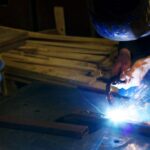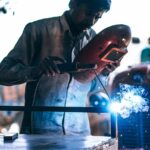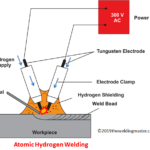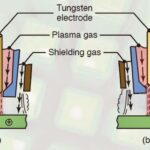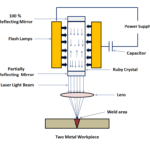Introduction:
Gas Tungsten Arc Welding (GTAW) is also known as Tungsten Inert Gas (TIG) Welding, which consists of a non-consumable electrode used to weld two different metal pieces. The Core temperature of Welding is very high and can reach up to 6500 °F. This is the main reason for the introduction of the Personal Protective Equipment (PPE) Kit such as welding helmets, gloves, welding boots, etc. The spark and other Harmful radiations can also cause severe effects in our body. Hence, Welding should be done with proper precautions and under the supervision of a good Welder. In this topic, we will explore this joining process in detail with its main parts, advantages, disadvantages, and application. So, let’s get started.
History of Development:

The development of this Welding technique starts with the development of the Electric arc in 1800, developed by Humphry Davy. C.L. Coffin was the first to create the Idea for Welding under Inert conditions in the 1890s, but the environment was difficult to establish and was not achieved until 1900. It was difficult to weld non-ferrous metals and dissimilar metals because of the rapid reaction with air and contamination. To solve this problem, use of bottle Inert gas was used at the beginning of 1930.
The process was made perfect in the 1940s, and the use of tungsten and helium started where tungsten was used as electrode and helium to produce an Inert atmosphere. In 1953, a new process based on Gas tungsten arc Welding was developed, called Plasma arc Welding. Due to the Industrial Revolution, automation in the Joining process started, and today we have different variations of this welding process available with us.
The Historical development, in brief, is as follows:
- 1800- Development of Electric arc by Humphry Davy
- 1890- An Idea for Inert gas popped up in the mind of C.L. Coffin
- 1930- Use of Bottle Inert gases started
- 1940- The use of Tungsten and Helium began, and it started the development of GTAW or TIG welding
- 1953- The development of Plasma arc welding took place
Main Parts of Gas Tungsten Arc Welding (GTAW)
Some parts are important for the smooth operation of this Joining process. Their parts are explained as follows:

1. Tungsten Electrode:
This Electrode is a non-consumable electrode type, which is not consumed during the welding process. It is used as an electrode in this Joining process because it can withstand very high temperatures without minimal melting and erosion.
2. Welding Machine:
The machine can be of Constant current (C.C.), A.C., DC+, DC-, or AC/DC type. The welding machine is used to create a balance during Welding, as it creates both positive and negative electrodes for the current generation and provides ground for any leakage of current.
3. Torch or Electrode Holder:
This holder is used to hold the different electrodes during the Joining process and provide the components to create positive and negative electrodes to develop the current and join the metal pieces.
4. Shielding Gas Supply:
The main used Inert gases are Helium, Argon, or the mixture. Argon is better for thinner metal pieces, and Argon or the mixture is used for thicker metal pieces.
5. Filler Metal Rod:
The Dimension of the rod is dependent upon the thickness of the metal to be welded. It is also advisable to use the rod with the same material as of workpiece during the welding process.
6. Personal Safety Equipment:
It is also called the personal protective equipment (PPE) Kit which includes welding helmet, jackets, gloves, goggles, welding boots etc and must be worn during any welding work. We should wear it during the TIG Welding to save us from heat, spark, and harmful radiation.
The PPE Kit includes welding helmets, welding jackets, Welding boots, Gloves etc.
Also Read:
- What is MIG Welding? – Complete Explanation
- What is Friction Welding – Definition, Working, Types, Advantages and Disadvantages.
- What is Arc Welding – Definition, Types, Working, Advantages and Disadvantages
Working of Gas Tungsten Arc Welding
Manual tungsten arc welding is one of the most challenging joining processes that is used in industries. It is because small contact length, great skill, and great care are required to prevent the contact between the metal and electrode. This joining process uses a filler metal that can be of a different material than the workpiece, but the same material produces a more effective weld.

To produce a spark, a high-frequency source is used to create the spark. The produced welding Spark creates a conducting path for the initiation of current from the electrode to the metal piece while maintaining a sufficient amount of gap (1.5- 3 mm). The current produces an adequate amount of heat to melt the Workpiece. The Workpiece is melted and joined together under the inert atmosphere. The used atmosphere may be helium-based, argon based, or the combination of two. The joined workpiece is then combined and solidified to become a single metal piece. The tungsten electrode used in the process remains unconsumed, and this is the main advantage of using this welding process.
For Better Understanding about Gas Tungsten Arc Welding (GTAW) or TIG Welding, Watch the Video Completely:
Welding Material Characteristics:
This Joining process is most commonly used for welding stainless steel and non-ferrous metals. It can, however, be used for all the metals, with the exception being Zinc and its alloys. The Welding positions allowed by this process include flat welding and non-flat welding depending upon the welder’s skill.
The following paragraphs will present the characteristic of this Welding process for different welding metals and dissimilar metals.
1. Steels (Carbon and Stainless):
For Welding carbon and stainless steel, good filler material is crucial to reduce the porosity. We should remove the oxide of metal present in the Welding material and filler metal immediately to produce any contamination. These can be done by polishing the surface before welding, which can remove any corrode the surface. Preheating is necessary for some Carbon steels to avoid the formation of Martensite steel (Brittle and high strength steel). A DCEN power source is usually used with the sharp-edged electrode. Pure argon can be used for thin metals, but helium can be used if thickness increases in the Inert atmosphere.
2. Aluminum and Magnesium:
Aluminum and Magnesium are welded using Alternating current, but the use of Direct current is also possible. The preheating of welding material before welding is necessary to remove any oxide from the metal pieces. The preheating temperature depends upon the metal and its thickness. Direct current of either positive and negative power source can be used for welding. The negative Direct current provides deeper penetration. The thoriated tungsten electrode is used with a pure argon shielding environment.
3. Dissimilar Metal:
Welding dissimilar metal is always tricky because they don’t fuse to form a strong weld. However, welding different metal finds various applications in the industries and can be used to reduce corrosion and oxidation. The implementation of dissimilar metals in this joining process can be done using proper filler metal. When welding different metals, the joint should be accurate, with proper dimension and bevel angles.
Weld Finish Quality:
This Joining process has greater control over the welding area than the other joining process. Hence, it produces a good weld finish if done by a skilled welder due to the Involved complexities. Maximum weld finish is maintained by ensuring the cleanliness of the workpiece during Welding. We can do it by properly washing the metal piece before Welding and polishing it using different grain sizes sandpaper to remove any oxide layer, oil, dust, and contamination.
The cleanliness is not very much required during the use of an Alternating current power source because it produces a self-cleaning of the weld surface during the Welding. It became absolutely necessary when we are using a negative type Direct electric current Power source. When we use this Joining process in a windy place, it is essential to increase inert gas as a shielding environment.
If the amount of Current becomes more than the electrode capacity, then the tungsten inclusion may take place in the welded metal, called Tungsten spitting. It can be identified using radiography and can be prevented by using a different type of electrode or changing the electrode diameter.
Safety:
Safety is the most important thing during any joining process. There is separate Personal protective equipment that is to be used during every welding process. This Welding process also produces a high amount of spark and harmful radiation, which can be detrimental if contacted. Different cases of red eyes, burns are reported during the improper use of these essential components.
The welder needs to wear protective clothing, which includes light and leather gloves. A protective long sleeve shirt with a high collar is often used to protect from the spark that can come on exposed skin and cause a severe burn. Potential arc light damage includes an accidental flash to the eye, skin damage equivalent to intense sunburn. Operators also use Welding helmets to protect from the vision of harmful radiations that can damage the eyes. Welders also contact harmful gas particles and contamination, which can cause dangerous effects in the body when swallowed. Hence, it is necessary to use the proper protective equipment during any Weld work, whether it is done in Industries or not.
Advantages of Gas Tungsten Arc Welding:
Tungsten inert gas welding or gas tungsten arc welding brings various advantages over other Joining processes. We have talked about a few of them in the above paragraphs and will be talking about them under the heading. Various advantages of using this Joining process are as follows:
- It uses a non-consumable electrode, which brings a bigger advantage over Arc welding, where much investment is required to bring new electrodes. This Welding process does not require any investment regarding the electrode. The same electrode is used to weld different weld materials.
- Filler metals can be added by hand when required. The advantage of using filler metal provides flexibility in the application of this welding process. The final weld finish is also dependent upon the material used as filler metal.
- The use of shielding gas provides an upper advantage, which saves the metal from different contamination. We can use Helium, argon, or a combination of two to produce an Inert atmosphere for protecting from contamination.
- It produces a high-quality clean weld, which we can achieve by providing certain factors and maintaining a proper gap between the electrode and weld metals.
- We can use it to weld different metals that range from Stainless steel to aluminum, Etc. The Only exception for Welding metal is Zinc and its alloy, which this process can’t weld.
- Dissimilar metals can also be joined using this Joining process. The only requirement is proper Joint and dimensioning of welding.
Disadvantages of GTAW:
Although the use of gas tungsten arc welding doesn’t bring advantages only, it has several disadvantages. We have already discussed some of the disadvantages in the above paragraphs. We will be discussing some more disadvantages in this heading. Various Disadvantages of using this Joining process are as follows:
- It has a very low filler deposition rate. It is thus a very time-consuming joining process that requires great skill and patience during work.
- It is a highly complicated process and requires great skill for a welder to perform this Welding process. The final weld finish depends on several factors that depend upon the constant gap between the electrode and the welded metal.
- It is a highly sensitive process in which a welder is exposed to high radiation and spark, which can cause severe damage. Hence, the use of proper Personal protective equipment is compulsory.
- The initial setup cost for usage in Industries or self-work is very high.
- Since the intensity of heat produced is very high, it can penetrate deep into the metal pieces. It is mostly not used for thinner sheet metals.
Applications:
Aerospace Industries use this Welding process in a very high amount, but it is also used in different Industries. Gas tungsten arc welding is mainly used for welding non-ferrous metal because it produces a perfect weld finish. It is used in the automobile industry to weld different body parts in white (BIW), which can’t be welded through other Joining processes. Apart from this, it is also used in Oil and Gas Industries to weld different pipes and boiler components. It is also a proper choice for critical welding operations such as nuclear power plants and thermal power plants.
FAQs:
Q 1: Is it possible to weld dissimilar metals using this Joining process?
Ans: Yes, it is possible to weld different materials together using this Joining process. The choice of filler metal determines the weld finish in this condition.
Q 2: What is Personal Protective equipment?
Ans: It is an item of personal clothing worn during any Joining process to be protected from sparks, harmful radiations, and heat generated by the process.
Q 3: How is Gas Tungsten Arc welding different from Simple Arc welding?
Ans: The working process for both the Joining process is the same, and the only difference is the use of electrodes. In simple arc welding, we use consumable electrodes, while in Gas tungsten arc welding, we use a thoriated tungsten non-consumable electrode.
Image Sources:
- https://en.wikipedia.org/wiki/Gas_tungsten_arc_welding

